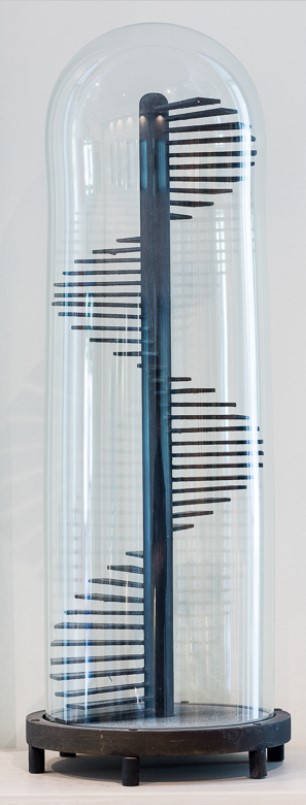Helena Mutanen

1998, Spiraltrappan, Mixed media H67 x D24
Interview
How would you describe what you were working on when you were awarded the Maria Bonnier Dahlin Scholarship and what did the scholarship mean to you?
In 1998 I was working with smaller objects and sculptures in various materials and techniques. I worked on a long-term project, Monument, which was a growing candle. In The Academy of Fine Arts' final exhibition in 1998, I showed two works. One was an installation with large seashells in which speakers were fitted. The installation was an audio work that played melancholy music. I also showed a poodle cast in aluminium titled Peruuk. The scholarship has meant a great deal. It is a good qualification and it is also fun to be noticed.
What discussions characterized the art scene at this time and what was particularly important you?
Discussions in Sweden revolved around the death of painting and the architecture of the then newly built Moderna Museum. Finishing my studies at the Royal Institute of Art and starting to do my artistic work in my own studio meant a lot to me.
What exhibitions, films and books were important to you and what music did you listen to?
The Sensation exhibition at the Royal Academy in London in September 1997 with the YBA, played a role for me. There were installations and sculptures by several artists that I like a lot. I watched horror movies and psychological thrillers. I listened to many different kinds of music, like Mazzy Star, Led Zeppelin and Death Before Disco, which I also named one work (the backbone of the chair) after.
If you would point out any individual person that you perceive as particularly influential in Swedish art at this time, who would it be and why?
Lars O Ericsson was an art critic at Dagens Nyheter who had a great influence on Swedish art at that time. If he wrote good criticism of an exhibition, the artist could get a lot of attention, and vice versa.
How would you describe the social and political climate that prevailed, and were there any questions or events that particularly affected your work?
I dug into my own background. My personal stories were important to me, as they still are. Of course, everyone is affected by the social climate of the times they are living in, but I have a hard time highlighting anything specific that would have affected my work at that time. It was a pretty eventful year, 1998. I felt the mood in society as dark and uneasy under the surface.
When you look back and compare the art life then and now, which are the most eye-catching changes?
Art reviews had more space in the newspapers. There were fewer galleries, exhibition rooms and fewer artists. There was a big art fair in Sollentuna where business people, art colleges and galleries met, all in one place. Today it is more widespread. In terms of content, the art has not changed so much. The technology has changed and improved. Better imaging for stills and video. It has simplified art production for many artists.
What are you working on today?
I am working on a project I call Jus soli and Jus Sanguinis that deals with issues of belonging. The project was started a couple of years ago and has resulted in a great hang textile sculpture, Conjoined Roots, which was shown at Open Art in Örebro in the summer of 2015. Next, the work is being modified and displayed in a constellation with additional works at the Pilane sculpture park summer 2016. These are the works I am working on right now. I have also for several years been developing a waxing technique for different textile materials, which I continuously investigate.
This is an excerpt from Samlade stipendiater! 30 år med Maria Bonnier Dahlins stiftelse, by Niclas Östlind, (red.) (2016). Stockholm: Bonnier fakta.